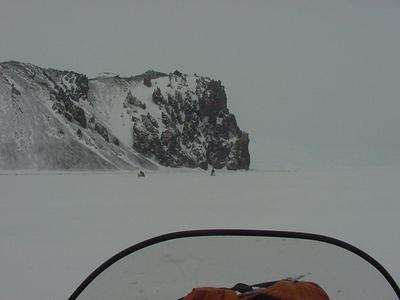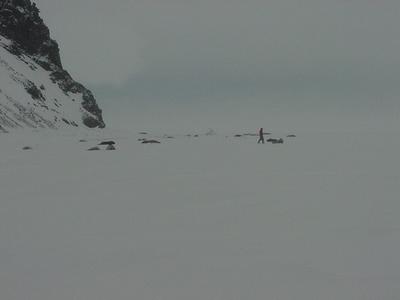11 November, 2000
FYI answer for 11/10/00
Weddell Seals teeth project forward at an angle greater than other seals. This adaptation allows them to 'rake' or scrape across ice hole openings to keep them from freezing shut.
Seals do not have weekends off. I discovered that the only time that we have a day off is when the weather is bad. Today was not that kind of day. My job is primarily going to be working with two Japanese scientists who are working for the first time with the Weddell seal population here in the Ross Sea fast-ice area of eastern Antarctica. Katsufumi Sato, the lead scientist and Yoko Mitani, a graduate student, are primarily studying the behaviors of the seals. They are using digital cameras and movement data recorders that are mounted on the backs of selected seals for this research. I will be helping with the procedures to capture, prepare, and attach these recording devices and also to recapture and detach. We will also be working with the four other members of our group every three days to take a count of all the Weddell seals in the entire area that we are studying. This covers seven major colonies, three smaller colonies, and a few very small groups throughout 82 square
miles.
I am primarily working in an area called Turks Head, which is named for the shape of the land formation, and Big Razorback Island, which is also named for its shape. Turks Head is about five miles from our camp. We get there by snowmobile. Big Razorback west is within walking distance. We take a daily count and census of these two areas to determine which adult female mother seals will be reliable enough to attach a camera or data recorder to in order to retrieve it a day later. Once we have our targets for the day, we have to attach the devices or previous attachments need to be retrieved.
The process of attachingthe camera or data recorder starts by 'bagging' the chosen seal. A special canvas bag is thrown over the seal's head and a person holds onto it with ropes. This keeps the seal from biting and it also calms the animal for handling. There is an anesthesia, which is sprayed into the end of the bag so the seal breathes it and goes to sleep temporarily. During that time, the back of the seal is cleaned and the mounting piece is attached using epoxy glue. The camera, data recorder or both, whichever is chosen for this day's work, is then placed into the mounting and fastened. Sometimes seals need blood samples taken and sometimes tissue samples are taken to look at DNA. Every step of the process is recorded. Even the time we start to try and 'bag' the seal is recorded. It is very important to treat the animal with care in approaching and handling.
The Weddell seal population has been studied for the past thirty-two years. The seals have a tag placed on both of their rear flippers. There are numerous pieces of information that are collected, but a few of the basics include the sex of the animal and where the animal is located in the area. Females that have pups are recorded each year, and new pups receive tags and their birthdays, as well as other basic information, are recorded for the census and study. Recent calculation and data have identified over 14,000 seals counted, tagged, and recorded in the past thirty-two years, just in this region of Antarctica.
FYI
There are ___________ species of 'pack' ice seals: Ross, Crabeater, and Leopard. There is ________ species of 'fast' ice seals: Weddell.
Pack ice is an ice flow that has broken from fast ice that remains ____________ to the land. Fast ice is ice that is fastened to the ________.

This mother seal has a camera and data logger on her back

I travel to Turks Head everyday to log the seals present and attach or remove data instruments. I get there by my snowmobile.

Big Razorback Island is just out our doors. I work here everyday also.
Contact the TEA in the field at
.
If you cannot connect through your browser, copy the
TEA's e-mail address in the "To:" line of
your favorite e-mail package.
|
